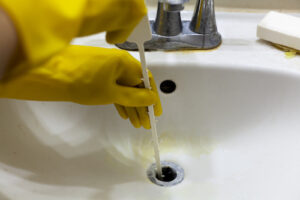
You’ll save time and money by not having a plumber clear your clogged drain with this simple, low-cost device that you can store in a sink cabinet.
When Should You Snake a Drain?
Use a drain snake when your sink, shower, or tub drain is slowing or not emptying at all due to soft obstructions up to 15 to 25 feet down the line. Snaking or augering a drain can often address water drainage issues that chemicals, plunging, or the use of a plastic hair snake can’t fix.
Drain snakes cannot take up heavy objects like rings or cut through obstacles in drainage pipelines.
What Is a Drain Snake and How Does It Work?
A drain snake, also known as a drain auger, is a metal cable coiled into a drum for protection. The cable can be as long as 25 feet. A corkscrew-style spring at the cable’s end clears obstructions in drains.
The cable uncoils from the drum and advances through the drain when pushed by hand. When the snake cable’s corkscrew end comes into contact with an object, the drum locks into position, allowing the cable to turn. By rotating, the sharp end grabs and holds on to the obstruction, allowing it to be drawn back and removed.
Considerations for Safety
Protect your eyes and hands by wearing safety glasses and gloves. If possible, flush the drain with water before snaking it if it contains drain-cleaning chemicals. If the water doesn’t drain, take the drain snake out slowly to avoid splashback.
What You’ll Need
Equipment / Tools
- Drain snake
- Bowl or shallow bucket
- Rags
- Old towels
- Plug wrench (for tubs and showers)
- Materials
- Paper towels (optional)
Instructions
Remove the P-Trap and gain access to the drain.
Reach into the sink cabinet and remove the P-trap for sink drains. The P-trap is a curved pipe with a diameter of 1 1/4 to 2 inches with a form similar to the letter P. This trap collects standing water to prevent sewage fumes from entering your property through the drain.
The P-trap can be completely removed by hand. Place the old towels on the sink cabinet’s floor. Under the P-trap, place the basin or bucket. Unscrew the plastic nuts. Drain the gathered water in the container by releasing the P-trap.
The trap is accessed through the overflow part of the drain in tubs. A manual snake may be tough to use here; an electric snake will easily get around the trap and down the pipes.
Remove the drain from showers. To begin, gently pull any screens or covers off using a flat-head screwdriver. Remove the drain by turning it counterclockwise with a plug wrench.
Extending the Cable
Remove the thumbscrew from the drain snake’s drum. Extend the cable by hand and insert it into the drain pipe. When you come upon an impediment, come to a halt.
Obstruction Snag
Tighten the drum’s thumbscrew. Turn the drain snake handle two or three times slowly.
The cable should be retracted.
Remove the thumbscrew and loosen it once more. Slowly pull the cable back toward you by hand.
A snake that clears drains
Clear the debris from the drain snake’s end. Remove the debris by twisting it counter-clockwise; you may need to remove and dispose of the blockage with a paper towel or other disposable cloth.
Keep clearing the pipe.
If you think there are more clogs, repeat the process, starting from the first step. Because you can’t verify drain flow without disassembling the sink’s drainpipe, it’s usually better to keep snaking the drain until the cable runs out.
Test Drain Flow
Reassemble the drainage pipe. Run the water to test for drainage.
The snake that cleans drains
It’s critical to cleanse the drain snake after snaking the drain. Bacteria-laden debris and hair will be trapped on the spring and cable and should not be withdrawn into the drum. In addition, if the cable is exposed to water, it will rust. Allow the cable to dry once it has been washed.
Snaking a Drain: Some Pointers
Before snaking the drain, do not pour caustic chemicals down it.
Make sure the cable is pulled straight out. It’s possible that turning it counter-clockwise will free the obstruction and allow it to re-enter the drainage pipe.
Continuing to revolve the drum and cable if the snake is trapped may cause the cable to kink up and become much more stuck. Turn the drum and cable in reverse, carefully backing the cable.
When to Call a Pro
Call in a plumber when the clog’s distance exceeds your drain snake’s length. Some drain augers may be either 15 feet or 25 feet.
Drain snakes pick up clogs but cannot cut through obstructions. CalTop Tier Plumbing and Rooter or a rooter-type service, their motorized sewer machines can bore through and dislodge solid items stuck in pipes.
Drain cleaning is fairly inexpensive, so if you’re uncertain about your ability to use the snake or clear the drain successfully, calling a pro at (951) 475-6521 is your best option. Out of the drain while locking the thumbscrew in place.

